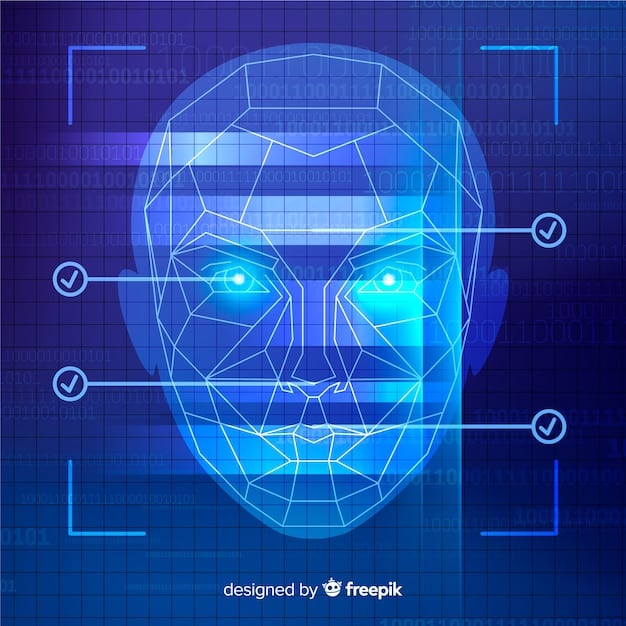Ethical Implications of AI Surveillance Technologies in the US

AI-driven surveillance technologies in the US present ethical dilemmas encompassing privacy violations, bias amplification, lack of transparency, and potential for misuse, necessitating careful consideration and regulation.
The rise of artificial intelligence has ushered in an era of unprecedented surveillance capabilities in the United States. While promising enhanced security and efficiency, these AI-driven surveillance technologies in the US also raise profound ethical questions that demand serious attention.
Understanding AI-Driven Surveillance
AI-driven surveillance refers to the use of artificial intelligence algorithms to analyze data collected through various surveillance methods. This data can include video footage, social media posts, internet browsing history, and even biometric information. The power of AI lies in its ability to identify patterns, predict behavior, and make decisions automatically, all at a scale that is impossible for humans to achieve.
How AI Enhances Surveillance
AI algorithms can analyze vast amounts of data in real-time, identifying potential threats or patterns of interest. This capability significantly enhances the efficiency and effectiveness of surveillance systems.
Different Types of AI Surveillance Technologies
From facial recognition to predictive policing, AI is being deployed in a variety of surveillance applications. Understanding these different technologies is crucial to understanding their ethical implications.
- Facial Recognition: Identifies individuals based on their facial features, used for security and law enforcement.
- Predictive Policing: Analyzes crime data to predict future criminal activity, guiding police deployment.
- Behavioral Analysis: Monitors online and offline behavior to detect anomalies or potential threats.
- Emotion Recognition: Attempts to infer a person’s emotional state based on facial expressions or voice patterns.
The integration of AI into surveillance technologies raises complex questions about privacy, civil liberties, and the potential for abuse. As these technologies become more sophisticated and widespread, it is crucial to address the ethical implications they pose.
The Erosion of Privacy
One of the primary ethical concerns surrounding AI-driven surveillance is the erosion of privacy. The ability of AI to collect and analyze vast amounts of personal data raises the specter of a society where individuals are constantly monitored.
Data Collection and Usage
AI surveillance systems collect data from a variety of sources, often without the explicit consent or knowledge of the individuals being monitored. This data is then used to create detailed profiles and make predictions about their behavior.
The Chilling Effect
The knowledge that one is being constantly watched can have a chilling effect on freedom of expression and association. People may be less likely to engage in activities that could draw the attention of surveillance systems, even if those activities are perfectly legal and legitimate.
The constant monitoring enabled by AI surveillance systems raises serious questions about the balance between security and individual liberty. It’s essential to establish clear guidelines and regulations to protect privacy rights in the age of AI.

Bias and Discrimination
AI algorithms are only as good as the data they are trained on. If the data reflects existing biases, the AI system will perpetuate and even amplify those biases, leading to discriminatory outcomes.
Algorithmic Bias in Surveillance
Studies have shown that facial recognition algorithms are less accurate when identifying individuals with darker skin tones, leading to a higher risk of misidentification and false accusations for these groups.
Disproportionate Impact on Marginalized Communities
AI-driven surveillance systems are often deployed in communities that are already marginalized, leading to further discrimination and oppression. This can create a self-fulfilling prophecy, where increased surveillance leads to more arrests, which then reinforces the perception that these communities are more prone to crime.
- Racial Profiling: AI systems may be used to target specific racial or ethnic groups, leading to discriminatory enforcement of laws.
- Socioeconomic Bias: Surveillance may be concentrated in low-income areas, further marginalizing residents.
- Gender Bias: Emotion recognition technologies may misinterpret women’s facial expressions, leading to unfair treatment.
Addressing bias in AI surveillance requires careful attention to the data used to train the algorithms, as well as ongoing monitoring to identify and correct discriminatory outcomes. It is crucial to ensure that these systems are used fairly and equitably, and not to perpetuate existing social inequalities.
Lack of Transparency and Accountability
Many AI surveillance systems operate in secrecy, making it difficult to understand how they work and how decisions are made. This lack of transparency raises concerns about accountability and the potential for abuse.
The Black Box Problem
AI algorithms can be complex and opaque, making it difficult to understand why they make certain decisions. This “black box” problem makes it hard to identify and correct errors or biases in the system.

Who is Responsible?
When an AI system makes a mistake or causes harm, it can be difficult to determine who is responsible. Is it the developer of the algorithm, the user of the system, or the organization that deployed it?
The Need for Oversight and Regulation
To ensure accountability, it is essential to establish clear lines of responsibility and implement strong oversight mechanisms. This may include independent audits, public reporting requirements, and legal recourse for individuals who are harmed by AI surveillance systems.
Transparency and accountability are essential to building trust in AI surveillance technologies. Without them, there is a risk that these systems will be used in ways that are unfair, discriminatory, or even abusive.
Potential for Misuse
AI-driven surveillance technologies can be misused for a variety of purposes, from suppressing dissent to targeting political opponents. The potential for abuse is particularly concerning in the hands of authoritarian governments or malicious actors.
Surveillance as a Tool for Oppression
AI surveillance can be used to monitor and control populations, suppress dissent, and punish those who challenge the status quo. This can have a chilling effect on democracy and human rights.
The Risk of Mission Creep
AI surveillance systems are often justified on the grounds of national security or law enforcement. However, there is a risk that these systems will be used for purposes beyond their original scope, such as monitoring political activists or tracking the movements of ordinary citizens.
- Political Targeting: AI systems could be used to identify and target political opponents or activists.
- Economic Espionage: Surveillance could be used to steal trade secrets or gain an unfair competitive advantage.
- Personal Harassment: AI-driven surveillance could be used to stalk or harass individuals.
Preventing the misuse of AI surveillance requires strong legal safeguards, independent oversight, and a commitment to transparency and accountability. It is crucial to ensure that these technologies are used to protect, not to oppress.
Navigating the Ethical Landscape
Addressing the ethical implications of AI-driven surveillance requires a multi-faceted approach, involving policymakers, technologists, and the public.
Developing Ethical Guidelines and Regulations
Clear ethical guidelines and regulations are needed to govern the development and use of AI surveillance technologies. These guidelines should address issues such as privacy, bias, transparency, and accountability.
Promoting Transparency and Explainability
Efforts should be made to make AI algorithms more transparent and explainable, so that it is easier to understand how they work and how decisions are made. This may involve developing new techniques for visualizing AI decision-making processes or creating tools that allow users to challenge the results of AI systems.
Engaging the Public in the Conversation
It is essential to engage the public in a broader conversation about the ethical implications of AI surveillance. This conversation should involve experts from a variety of fields, as well as ordinary citizens who are affected by these technologies.
By working together, we can ensure that AI surveillance technologies are used in ways that are ethical, responsible, and beneficial to society.
The Path Forward: Balancing Security and Ethics
The challenge of AI-driven surveillance lies in finding a balance between the potential benefits of these technologies and the ethical risks they pose. It’s about harnessing the power of AI for security and efficiency while safeguarding fundamental rights and values.
Embracing Privacy-Enhancing Technologies
The development and implementation of privacy-enhancing technologies can play a crucial role in mitigating the negative impacts of AI surveillance. Techniques like differential privacy, homomorphic encryption, and federated learning can help protect personal data while still allowing for valuable insights to be extracted.
Fostering a Culture of Responsible Innovation
A culture of responsible innovation is essential for ensuring that AI technologies are developed and deployed in a way that aligns with societal values. This requires a commitment to ethical principles, transparency, and accountability throughout the entire AI lifecycle.
The future of AI-driven surveillance depends on our ability to navigate the ethical challenges it presents. By prioritizing privacy, fairness, and accountability, we can harness the power of AI to create a safer and more just society.
| Key Aspect | Brief Description |
|---|---|
| 🛡️ Privacy Erosion | AI surveillance collects vast data, potentially chilling free expression. |
| ⚖️ Bias Amplification | Algorithms can perpetuate discrimination, impacting marginalized groups. |
| 🔒 Lack of Transparency | Opaque AI systems hinder accountability and oversight. |
| злоупотреба Misuse Potential | AI surveillance can be exploited for oppression, requiring safeguards. |
Frequently Asked Questions
▼
AI-driven surveillance uses artificial intelligence to analyze data from various sources like video, social media, and biometric info to enhance security and predictions.
▼
AI surveillance collects data often without consent, creating detailed profiles. This constant monitoring can deter freedom of expression and association.
▼
Algorithmic bias occurs when AI systems trained on biased data perpetuate discrimination, often disproportionately affecting marginalized communities.
▼
Transparency ensures accountability by allowing understanding of how decisions are made. This helps identify and correct errors, preventing potential misuse.
▼
AI surveillance can be misused to suppress dissent, target political opponents, or conduct economic espionage, impacting democracy and human rights.
Conclusion
The ethical implications of AI-driven surveillance technologies in the US are vast and complex, demanding ongoing scrutiny and proactive measures. By addressing concerns like privacy erosion, bias amplification, lack of transparency, and potential for misuse, we can navigate this technological landscape responsibly, safeguarding fundamental rights and fostering a more equitable society.





